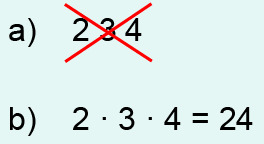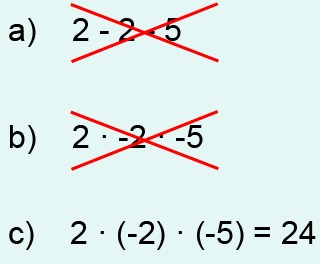10. Variable expressions
Exercises
Variable expressions
In most countries, temperatures are reported in degrees Celsius, but in some countries, such as the United States, degrees Fahrenheit are used. There is a certain relationship between the different temperature scales, which can be expressed as a mathematical expression. Degrees Celsius can be converted to degrees Fahrenheit by using the expression [[$ F = \dfrac{9}{5}C + 32 $]], where [[$ F $]] is the temperature in degrees Fahrenheit and [[$ C $]] is the temperature in degrees Celsius.
The Fahrenheit expression can be used over and over again by placing different temperatures in place of [[$ C $]]. Therefore, it is an example of a variable expression. The letter [[$ C $]] represents a variable that can have different values. In variable expressions, the multiplication sign is omitted when the product of a number and a variable or several variables are entered. However, the sign must be marked when placing a numeric value in place of a variable. In addition, if the value of the variable is negative, it must be enclosed in brackets. Two calculation signs cannot occur in a row without brackets.
Example 1
Calculate what a Fahrenheit scale thermometer shows if the outside temperature in degrees Celsius is a) 5 °C, b) –15 °C?a) Place the number 5 in the place of the variable [[$ C $]] and calculate the value of the expression.

b) Place the number -15 in the place of the variable [[$ C $]] and calculate the value of the expression.

Answer: a) 5 °C is 41 °F in Fahrenheit. b) –15 °C is 5 °F in Fahrenheit.
Typical errors when placing variable values
Place values [[$ x=3 $]] and [[$ y=4 $]] in the expression [[$ 2xy $]].

a) Incorrect!
You forgot the multiplication signs.
b) Correct!
Place values [[$ x=-2 $]] and [[$ y=-5 $]] in the expression [[$ 2xy $]].

a) Incorrect!
You forgot the multiplication signs.
b) Incorrect!
You forgot the brackets!
c) Correct!
Variables
Calculating with letters may seem strange at first, but they can be used to make mathematical models of real-life phenomena. Usually mathematical models are so complex that one variable is not enough to describe them. For example, in the global population growth model, the variables are A = population at the beginning, t = time in years, and k = growth factor. The population V at the end of t years is calculated with the formula [[$ V = Ak^t $]].
The growth factor k is affected by many factors such as diseases, wars, and famine. Therefore, it is difficult to assess it in advance. However, it is known that the world's population growth is slowing down, in the 1960s the growth rate was 1.02 (this means that the population grew by 2% per year) and at the end of 1990 it was 1.015. It is estimated that by 2015, the growth rate will drop to 1.01.
Example 2
Calculate the estimated population of the planet in 20 years from 6.7 billion in 2008. Calculate the estimation using first a growth factor of 1.015 and then a growth factor of 1.01.
List all the variables given in the task:
A = 6.7 billion
k = 1.015
t = 20 years
[[$ V = Ak^t = \text{6.7} \cdot \text{1.015}^{20} \approx \text{9.0} $]] billion
Calculate the second estimate using a growth factor of 1.01.[[$ V = Ak^t = \text{6.7} \cdot \text{1.01}^{20} \approx \text{8.2} $]] billion
Answer: The estimated population of the planet after 20 years is 9.0 billion (growth factor 1.015) or 8.2 billion (growth factor 1.01).